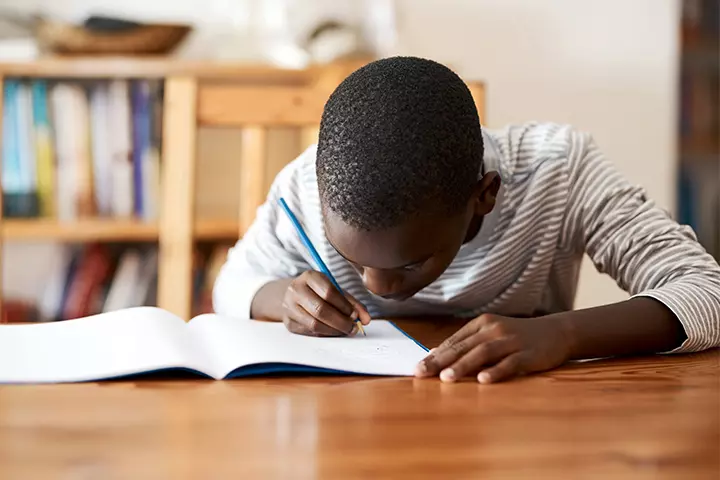
There are many benefits of good handwriting for kids. It is a great skill that helps a child in the long term. Apart from building a favorable image of the child, it may also boost their spirits, memory, focus, and hand-eye coordination.iAn important cognitive skill of performing movements with hands while being guided by the eyes.
If your child has disorganized writing skills, they are noticeable from a young age. Therefore, it is essential to teach children the appropriate ways to write before they develop bad writing practices. Small changes could help make a huge difference in enhancing your child’s handwriting.
If you are looking for valuable tips that could help in improving your child’s handwriting, then this post is for you.
Key Pointers
- Good handwriting requires the use of the ideal pen or pencil and the proper grasping technique.
- A child’s handwriting can be affected by writing too quickly and forcefully.
- It may also be beneficial to create a relaxing environment and make writing enjoyable.
- You can also use lined paper and handwriting worksheets to guide your children.
Why Is Writing Important For Students?
Writing is an important skill for students that helps them in academic disciplines and real-world scenarios. Here are some reasons why writing is important for students:
- Academic success: Students who can present their ideas neatly may find more success in exams, essays, research papers, and other academic assignments.
- Communication skills: Writing helps students articulate their thoughts and ideas effectively. This ability to communicate clearly in writing is valuable in academic and professional settings.
- Self-evaluation: Writing allows students to reflect on their experiences, learning, and personal growth. It promotes self-evaluation and the development of a deeper understanding of oneself.
- Professional growth: As students progress in their education, writing helps them in their professional development. Cover letters, resumes, and other professional documents require strong writing skills.
In summary, writing is a fundamental skill that empowers students academically, professionally, and personally.
How To Improve Handwriting For Kids?
Here are a few simple ways and instructions through which you can help your children improve their handwriting.
1. Use the right pencil or pen

Using the right stationery is one of the elementary steps to improve handwriting. Pens and pencils that are too thick or too thin can make writing difficult. The pen or pencil should be of the right size for your child’s hands to hold it appropriately and write in a proper flow. Young children in preschool or kindergarten who have a weak grasp may have an easier time using a thick pencil or crayons. Using golf-sized (very short) pencils encourages children to use an appropriate grasp rather than using their entire fist to hold it, as children tend to do initially. Not just the pen or pencil, even the paper should be high-quality to obtain good lettering or handwriting.
2. Ensure the right grasp
The right grasp and hand position are crucial for producing good handwriting
. The most effective method of holding a pencil is the ‘tripod grasp.’ To achieve it, you position the writing instrument between the thumb and the index finger while it rests on the side of the middle finger. The ring and small finger curl into the palm. The child should have a firm yet relaxed grip that allows them to write smoothly without straining or exhausting their fingers.
You can encourage children to use crayons, cut with scissors, thread beads on string or pipe cleaners, build with small connecting blocks, use tweezers or clothespins to pick up objects, and try finger painting to promote the tripod grasp. It’s important to do these exercises during the formative years to develop a strong foundation in handwriting, which can lead to confidence and legibility as they get older.
Tip: If you child continues to have difficulty achieving the tripod grasp, try using pencil grips. These reduce fatigue and prevent muscle cramps, resulting in improved handwriting.
3. Write at the right speed

Setting the right pace is important. When children write too fast, they lose control, cannot accurately form letters, and make mistakes. Similarly, slow writing could cause them to lose interest.
Speedy writers will usually slow down if they are asked to review and edit each word or sentence (depending on their developmental level) immediately after they’ve written it rather than waiting until the end of the writing task. Having a child spend time editing all of their illegible letters and words will encourage them to take the time to write them correctly the first time. Take notice of your child’s current pace and work toward improving it to one which will allow them to write the best quality letters. Consistent practice will help improve your child’s writing speed. Remember to let your child scribble and doodle at their own pace so they won’t lose interest.
4. Use the right pressure
Many children apply too much pressure by pressing their pen or pencil tip too hard on the paper. It stresses their fingers, makes it harder to create smooth lines, decreases their legibility, and may even cause the paper to tear.
The grip should be light but firm. Lighter pressure allows the hand to move smoothly. It will help make your child’s handwriting neat and the cursive script, aesthetically pleasing. You have to be patient as it takes practice to find the right pressure.
To help your child learn how much pressure to use when writing, try using a mechanical pencil. This serves as an effective reminder because the lead tip will break if they press too hard. There are also fun ways to practice pencil pressure without actually writing! Give your child a small picture to color using only a lead pencil, and help them explore how to make different shades of grey by altering the amount of pressure applied. At snack time, have your child try to pick up small marshmallows using tweezers without leaving any indentationsiThe spaces or gaps left at the beginning of a line or paragraph of text. .
5. Make writing fun

Children will likely become bored if they are asked to write the same letters or words over and over again. Make writing fun and purposeful for them. Rather than copying or tracing words in copybooks, introduce exciting elements to motivate them and make it a non-stressful affair. Consider interactive writing exercises like tracing letters in sand, writing letters using finger painting, or creating letters out of playdough, to make handwriting practice more fun. You can also try writing games for kids to make the process even more entertaining.
From scribbling, doodling, filling crossword puzzles, playing hangman, anagramsiWords or phrases that are made up of the same letters as another word or phrase but arranged in a different order. and simple word puzzles, try things that are likely to make writing fun. You can even give them rainbow-colored pencils or pens to make writing exciting. Many children also enjoy writing with Q-tips and paint, using chalk to write outdoors, and completing MadLibs. Older children might like to help you write the weekly grocery list or write a letter to a favorite athlete or movie star.
6. Strengthen fingers and wrist
Writing involves the muscles of fingers, wrist, and palm. It’s essential to strengthen these muscles to prevent fatigue and improve stamina.
Several non-writing activities, such as coloring, drawing, using spoons and forks, sewing, knitting, playing board games, kneading and playing with dough, using tweezers or clothespins to sort small objects, and wheelbarrow walking (child walks on their hands while the adult holds their ankles in the air) or imitating animal walks that include the child supporting a significant amount of their weight on their hands, can all strengthen fingers and wrists and improve dexterity and hand-eye coordination.
7. Increase reading time

Did you know reading can improve writing? The more a child sees well-proportioned and neatly printed letters, the higher the chances they’ll use them while writing and improve their handwriting.
8. Ensure an appropriate environment
When your child is practicing writing, make sure the environment is conducive. A comfortable chair that allows a child to rest their feet on the floor or a foot rest and a table or desk that comes to approximately elbow-height when the child is sitting will put their body in the best position to write. Distractions can negatively affect learning and make it hard for them to absorb information and stay engaged, so finding a quiet area is important. A well lit room will allow your child to clearly see their work.. Comfort, noise, and lighting can all affect writing skills.
9. Set a schedule
Establish a consistent time each day or week to practice writing. You will need to pick a time when they are not watching their favorite TV show, and their tummies are full. Try not to schedule before playtime as they might have more difficulty concentrating and focusing on their work. Writing practice tends to work well when scheduled after a gross motor activity so the child gets their “wiggles out” before attempting to complete quiet, seated tasks.
10. Do not force
Forcing a child to practice handwriting is not a solution. It’s important to be calm and patient while you help your child. Even if they make mistakes, point out only one mistake at a time and help them with corrections. Being positive will improve their morale and ensure they learn from their mistakes.
Also, take it slow and teach them one letter or word at a time rather than multiple sentences at once. It’s important to give them breaks to get up and stretch, do a few jumping jacks, or use the restroom. These simple tips will make the learning process more enjoyable for everyone.
Cursive writing can make learning more fun and easy. Danielle M. Welling, a blogger, recounts her experience of practicing cursive writing as a kid. She says, “I finally began to learn cursive in 2nd grade. By 3rd grade, I was writing fluently in cursive, and I haven’t stopped since.I still haven’t lost my fascination with cursive and beautiful handwriting. Today, when I am not typing my papers and notes, I write almost exclusively in cursive (i).”
11. Focus on posture

Correct posture can significantly help improve handwriting. Sitting on the floor or couch while writing is not the best posture for legible writing. Have your child sit on a sturdy chair and ask them to rest their arms on the table. Their torsoiThe central part of the human body, which includes the chest, abdomen, and back. should be upright, and their feet well-supported on the ground. Such a posture prevents strain on the muscles and helps improve handwriting. If your child’s feet cannot reach the ground, stack several thick books under their feet until they can rest comfortably.
12. Use handwriting worksheets and lined papers
Writing on ruled lines will help a child learn the appropriate size of letters. In other words, the lowercase “a” is half the height of a capital “A.” Lines also ensure that the handwriting is straight and not downhill or uphill.
Tip: If you’re using a blank sheet of paper, you can use a ruler to draw light lines. If needed, a highlighter or thick marker can be used to visually emphasize the lines. Using guided material will help improve penmanshipiThe skill and style of writing by hand using a pen or pencil. and build confidence. Young children can improve their handwriting by using a printed worksheet that includes traceable alphabets and numbers.
13. Be flexible
Take baby steps with your child. Asking them to write too much can result in frustration and fatigue which leads to illegible handwriting. Begin with a brief, five-minute practice and increase gradually. Moreover, too many rules could make the process of practicing handwriting less enjoyable. Therefore, focus on breaking down the practice to focus on only one or two skills at a time for better results.
Tip: Don’t just tell your child to write and practice. Instead, make it a fun-filled experience by asking thought-provoking questions or writing out a few words and letting them complete the page.
Frequently Asked Questions
1. What causes poor handwriting in kids?
When young children begin writing, their handwriting is often messy. However, their handwriting improves with persistent practice. Still, in some cases, the child may continue to have poor handwriting. Some of the factors that may be causing the issue are poor postural control, poor fine motor skills, and poor visual tracking (1).
2. What are the signs that my child needs help with handwriting?
Your child may need help with their handwriting if they are constantly frustrated while writing, if their writing looks messy and illegible, or if they have difficulty forming the letters consistently. When you notice such signs, consult a pediatric occupational therapist and help them practice their handwriting based on their needs.
3. How long should kids practice handwriting?
There’s no fixed time when children should practice handwriting. Ideally, a child should practice writing until the letters they write are clear enough to read. For this, a daily session of ten minutes is advised for young children, whereas for older children, the practice session could be planned for a longer duration.
4. What are the benefits of handwriting for children?
Handwriting offers children benefits such as improved fine motor skills, increased cognitive development, and better retention of information. In addition, writing engages multiple senses and enhances neural connections in the brain. Essentially, handwriting lays the foundation for the overall development of your child.
5. What are the effects of handwriting on a child’s cognitive development?
Handwriting positively affects a child’s cognitive development by promoting neural connections, enhancing information processing, and improving memory retention. The physical act of writing engages various areas of the brain and strengthens cognitive skills (4).
6. How does handwriting help to improve a child’s memory?
Handwriting helps improve a child’s memory by engaging multiple senses and stimulating the brain’s neural pathways. It creates a stronger connection between written information and memory recall, enhancing overall retention and retrieval abilities (5).
7. What are some tips for parents to help their children with handwriting practice?
To help your kids improve their handwriting, be consistent and set up a schedule so they can practice routinely. Don’t pressurize them; instead, encourage them when you see improvement. This will boost their confidence and help them do better. Also, give them a writing space where they can practice peacefully without distractions.
Writing is an essential life skill that allows individuals to express themselves in words. Good handwriting enhances reader fluency. It also helps in the child’s education and academics in a big way. So, parents should encourage children to practice writing, though without forcing. Good handwriting for kids can be improved by doing simple things, such as using the right pencil and writing at the right speed. As a parent, you need to support your child and help them at every step. Consistent efforts and diligent practice will make your child a fine penman in no time.
Infographic: Effective Ways To Improve Handwriting For Children
Children with good handwriting often score well in academics and show more interest in writing. Are you thinking of ways to improve your child’s handwriting? We bring helpful tips in this infographic to support your child(ren) get neat and legible handwriting. Illustration: Momjunction Design Team
Illustration: Best Effective Ways To Improve Handwriting For Kids

Image: Stable Diffusion/MomJunction Design Team
Learn five essential practices for teaching handwriting to children. Get tips on how to make handwriting fun and engaging for kids. Improve their writing skills and help them develop a lifelong love of writing.
Personal Experience: Source
MomJunction articles include first-hand experiences to provide you with better insights through real-life narratives. Here are the sources of personal accounts referenced in this article.
i. Cursive Handwriting: A Reflection.http://massillonlibrary.blogspot.com/2015/03/cursive-handwriting-reflection.html
References
- Handwriting Difficulty (Children).
https://www.nuhs.edu.sg/patient-care/find-a-condition/handwriting-difficulty-children - The effects of handwriting experience on functional brain development.
https://www.ncbi.nlm.nih.gov/pmc/articles/PMC4274624/ - Left- handedness- Better Health Channel
https://www.betterhealth.vic.gov.au/better-health-channel - The Importance of Teaching Handwriting for Cognitive Development
https://pld-literacy.org/the-importance-of-teaching-handwriting-for-cognitive-development/ - Eva Ose Askvik et al; (2020); The Importance of Cursive Handwriting Over Typewriting for Learning in the Classroom: A High-Density EEG Study of 12-Year-Old Children and Young Adults
https://www.frontiersin.org/journals/psychology/articles/10.3389/fpsyg.2020.01810/full
Community Experiences
Join the conversation and become a part of our nurturing community! Share your stories, experiences, and insights to connect with fellow parents.
Read full bio of Dana Sciullo
Read full bio of Bharathi V
Read full bio of Harshita Makvana
Read full bio of Kavita Kankani


















